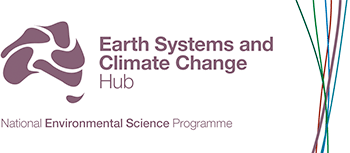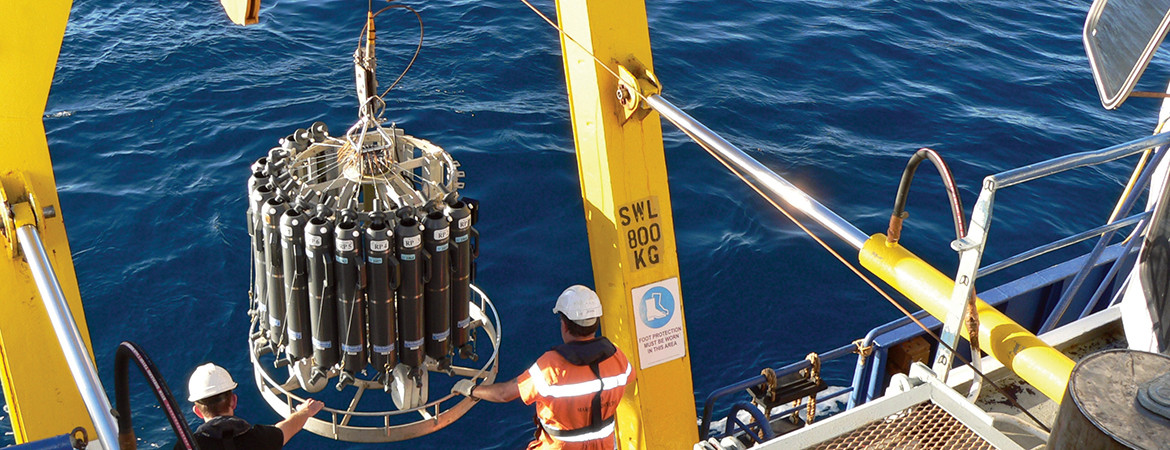PROJECT 2.4: Changing oceans and Australia’s future climate
This project ran from 1 July 2016 until 30 June 2019
Ocean heat uptake is one of the primary rate-setters of global warming. Over 93% of the extra heat stored by the Earth over the past 50 years is found in the ocean. To date this has not been well integrated into Australia’s climate models. To interpret past changes, and better simulate changes in the climate we need to understand how the ocean takes up heat, and how ocean heat uptake may change as the planet warms.
We’ve used data collected from ocean monitoring (historical archives, Argo floats and research vessels) to improve understanding of past changes in ocean temperature and salinity. We used this data to identify sources of bias in ocean heat update efficiency in climate models, as well as to examine the connection between ocean salinity changes and water balance over Australia.
This research has led to better representation of ocean processes in climate models, which will improve projections of future warming, sea-level rise and water availability for Australia. This work has also informed ocean-related climate change policy.
Outcomes from this project will be used in the current Hub Project 5.7 – Tracking ocean change: ocean observations and models.
Key project achievements include:
- Delivered high quality ocean data to a broad community of users in Australia and overseas
- Delivered new insights into the link between oceans and climate
- Delivered new knowledge targeted to user needs
For more information
Dr Steve Rintoul, CSIRO
Watch the Project 2.1 summary video
June 2019
Publications and papers
- Aoki S, Kobayashi R, Rintoul SR, Tamura T, Kusahara K. 2017. Changes in water properties and flow regime on the continental shelf off the Adélie/George VLand coast, East Antarctica, after glacier tongue calving, Journal of Geophysical Research: Oceans, 122, 6277-6294, doi:10.1002/2017jc012925 | Full paper
- Carter BR, Feely RA, Wanninkhof R, Kouketsu S, Sonnerup RE, Pardo PC, Sabine CL, Johnson GC, Sloyan BM, Murata A, Mecking S, Tilbrook B, Speer K, Talley LD, Millero FJ, Wijffels, Macdonald AM, Gruber N, Bullister JL. 2019. Pacific Anthropogenic Carbon between 1991 and 2017, Global Biogeochemical Cycles, doi: 10.1029/2018GB006154 | Full paper
- Cyriac A, McPhaden MJ, Phillips HE, Bindoff NL, Feng M. 2019 Seasonal Evolution of the Surface Layer Heat Balance in the Eastern Subtropical Indian Ocean, Journal of Geographic Research – Oceans, doi: 10.1029/2018JC014559 | Abstract
- Gao L, Rintoul SR, Yu W, 2018. Recent wind-driven changes in Subantarctic Mode Water and its impact on ocean heat storage, Nature Climate Change, 8, 58 | Full paper
- Greene CA, Blankenship DD, Gwyther DE, Silvano A, van Wijk E. 2017. Wind causes Totten Ice Shelf melt and accelaration, Science Advances, 3, 11, e1701681, doi: 10.1126/sciadv.1701681| Full paper
- Lago V, Wijffels SE, Durack PJ, Church JA, Bindoff NL, Marsland SJ. 2016. Simulating the Role of Surface Forcing on Observed Multidecadal Upper-Ocean Salinity Changes, Journal of Climate, 29, 5575-5588, doi: 10.1175/Jcli-D-15-0519.1 | Full paper
- Lambelet M, van de Flierdt T, Butler ECV, Bowie AR, Rintoul SR, Watson RJ, Watson RJ, Remenyi T, Lannuzel D, Warner M, Robinson LF, Bostock HC, Bradtmiller LI. 2018. The neodymium isotope fingerprint of Adélie Coast Bottom Water. Geophysical Research Letters, 45, doi:10.1029/2018GL080074 | Full paper
- Langlais C, Lenton A, Matear R, Monselesan D, Legresy B, Cougnon E, Rintoul SR. 2017. Stationary Rossby waves dominate subduction of anthropogenic carbon in the Southern Ocean. Stationary Rossby waves dominate subduction of anthropogenic carbon in the Southern Ocean, Scientific Reports, 7, 17076, doi:10.1038/s41598-017-17292-3 | Full paper
- Mao HB, Feng M, Phillips HE, Lian SL. 2019. Mesoscale eddy characteristics in the interior subtropical southeast Indian Ocean, tracked from the Leeuwin Current system. Deep-sea Research Part II, 52-62, doi:10.1016/j.dsr2.2018.07.003 | Pre-print version. An edited version of this paper was published by Elsevier Ltd. Copyright 2019 Elsevier Ltd | Abstract
- Palmer MD, Boyer T, Cowley R, Kizu S, Reseghetti F, Suzuki T, Thresher, A. 2018. An Algorithm for Classifying Unknown Expendable Bathythermograph (XBT) Instruments Based on Existing Metadata. Journal of Atmospheric Oceanic Technology, 35, 429–440. doi: 10.1175/JTECH-D-17-0129.1 | Full paper
- Pardo PC, Tilbrook B, Langlais C, Trull TW, Rintoul SR, 2017. Carbon uptake and biogeochemical change in the Southern Ocean, south of Tasmania, Biogeosciences, doi:10.5194/bg-14-5217-2017 | Full paper
- Patel RS, Phillips HE, Strutton P, Lenton A, Llort J. 2019. Meridional Heat and Salt Transport Across the Subantarctic Front by Cold‐Core Eddies, Journal of Geographical Research: Oceans, 124(2), doi:10.1029/2018JC014655 | Full paper
- Purkey SG, Johnson GC, Talley DL, Sloyan B M, Wijffels SE, Smethie W, Mecking S, Katsumata K. 2018. Unabated Bottom Water Warming and Freshening in the South Pacific Ocean. Journal of Geophysical Research: Oceans, doi: 10.1029/2018JC014775 | Full paper
- Raes EJ, Bodrossy L, van de Kamp J, Bissett A, Ostrowski M, Brown M, Sow SLS, Sloyan B, Waite AM. 2018. Oceanographic boundaries constrain microbial diversity gradients in the South Pacific Ocean. PNAS, doi: 10.1073/pnas.1719335115 | Full paper
- Rintoul SR, Silvano A, Pena-Molino B, van Wiyk E, Rosenberg M, Greenbaum JS, Blankenship DD. 2016. Ocean drives rapid basal ice melt of Totten Ice Shelf, Science Advances, 2(12), doi:10.1126/sciadv.1601610 | Full paper
- Rintoul SR, 2018. The global influence of localized dynamics in the Southern Ocean, Nature, 558, 209-218, doi:10.1038/s41586-018-0182-3 | Pre-print version. An edited version of this paper was published by Springer Nature Publishing AG. Copyright 2018 Springer Nature Publishing AG | Abstract
- Rintoul SR, Chown SL, DeConto RM, England MH, Fricker HA, Masson-Delmotte V, Naish TR, Siegert MJ, Xavier JC. 2018. Choosing the future of Antarctica. Nature, 558, 233-241, doi: 10.1038/s41586-018-0173-4 | Pre-print version. An edited version of this paper was published by Springer Nature Publishing AG. Copyright 2018 Springer Nature Publishing AG | Abstract
- Silvano A, Rintoul SR, Herraiz-Borreguer 2016. Ocean-Ice Shelf Interaction in East Antarctica. Oceanography, 29(4), 130–143 | Full paper
- Silvano A, Rintoul SR, Kushahara K, Pena-Molino B, van Wijk E, Gwyther DE, Williams GD. 2019. Seasonality of Warm Water Intrusions Onto the Continental Shelf Near Totten Glacier, Journal of Geophysical Research – Oceans, doi:10.1029/2018JC014634 | Full paper
- Silvano A, Rintoul SR, Peña-Molino B, Williams GD. 2017. Distribution of water masses and glacial meltwater on the continental shelf near the Totten Glacier. Journal of Geophysical Research – Oceans, 122, 2050–2068, doi:10.1002/2016JC012115 | Full paper
- Silvano A, Rintoul SR , Peña-Molino B, Hobbs WR, Aoki S, Orsi AH and Williams GD. 2018. Freshening by glacial meltwater enhances melting of ice shelves and reduces formation of Antarctic Bottom Water, Science Advances, Vol. 4, doi: 10.1126/sciadv.aap9467 | Full paper
- Sloyan BM, Wanninkhof R, Kramp M, Johson GC, Talley LD, Tanhua T, McDonagh E, Cusack C, O’Rouke E, McGovern E, Katsumata K, Diggs S, Hummon J, Ishii M, Azetsu-Scott K, Boss E, Ansorge I, Perez FF, Mercier H, Williams MJM, Anderson L, Lee JH, Murata A, Kouketsu S, Jeansson E, Hoppema M, Campos E. 2019. The Global Ocean Ship-Based Hydrographic Investigations Program (GO-SHIP): A Platform for Integrated Multidisciplinary Ocean Science, Frontiers of Marine Science, doi:10.3389/fmars.2019.00445 | Full paper
- Sloyan BM, Wilkin J, Hill KL, Chidichimo MP, Cronin MF, Johannessen JA, Karstensen J, Krug M, Lee T, Oka E, Palmer MD, Rabe B, Speich S, von Schuckmann K, Weller RA, Yu WD, 2019. Evolving the Physical Global Ocean Observing System for Research Application Services Through International Coordination, Frontiers of Marine Science, doi:10.3389/fmars.2019.00449 | Full paper
- Snow K, Rintoul SR, Sloyan BM & Hogg AM. 2018. Change in Dense Shelf Water and Adelie Land Bottom Water precipitated by iceberg calving. Geophysical Research Letters, 45, 2380-2387, doi:10.1002/2017gl076195 | Full paper
- Sprintall J, Gordon AL, Wijffels SE, Feng M, Hu SJ, Koch-Larrouy A, Phillips HE, Nugroho D, Napitu A, Pujiana K, Susanto RD, Sloyan BM, Pena-Molino B, Yuan D, Florida Riama N, Siswanto S, Kuswardani A, Arifin Z, Wahyudi AJ, Zhou H, Nagai T, Ansong JK, Bourdalle-Badié R, Chanut J, Lyard F, Arbic BK, Ramdhani A, Setiawan A. 2019. Detecting Change in the Indonesian Seas, OceanObs’19 white paper, Frontiers in Marine Science, 6, doi:10.3389/fmars.2019.00257 | Full paper
- Stammer D, Bracco A, AchutaRao K, Beal L, Bindoff NL, Braconnot P, Cai WJ, Chen D, Collins M, Danabasoglu G, Dewitte B, Farneti R, Fox-Kemper B, Fyfe J, Griffies SM, Jayne SR, Lazar A, Lengaigne M, Lin XP, Marsland SJ, Minobe S, Monteiro PMS, Robinson W, Roxy MK, Rykaczewski RR, Speich S, Smith EIJ, Solomon A, Storto A, Takahashi K, Toniazzo T, Vialard J. 2019. Ocean climate observing requirements in support of Climate Research and Climate Information, Frontiers of Marine Science, doi:10.3389/fmars.2019.00444 | Full paper
- Stewart KD & Hogg AMc. 2019. Southern Ocean heat and momentum uptake are sensitive to the vertical resolution at the ocean surface, Ocean Modelling, 143, doi:10.1016/j.ocemod.2019.101456 | Abstract
- Szuts ZB, Bower AS, Donohue KA, Girton JB, Hummon JM, Katsumata K, Lumpkin R, Ortner PB, Phillips HE, Rossby T, Shay LK, Todd RE. 2019. The scientific and societal uses of global measurements of subsurface velocity, Frontiers of Marine Science, 6, doi:10.3389/fmars.2019.00358 | Full paper
- Zhang Y, Feng M, Du Y, Phillips HE, Bindoff NL, McPhaden MJ. 2018. Strengthened Indonesian throughflow drives decadal warming in the Southern Indian Ocean. Geographical Research Letters, doi: 10.1029/2018GL078265 | Full paper
This project is contributing to meeting the following climate challenges:
Oceans are the dominant source of water vapour that feeds precipitation over land. Surface ocean warming is driving an enhanced hydrological cycle. We’re monitoring ocean salinities, which can help track that process.
Ocean warming rates and patterns set regional sea level rise rates. Our work will improve projections of ocean warming rates, which will enable more accurate regional projections of sea level rise and extremes.
As the climate system’s heat reservoir, the rate of change of ocean heat content relates directly to Earth’s warming rate. Our work tracking and understanding global ocean heating rates is the only practical means of tracking the efficacy of global greenhouse gas mitigation efforts.




